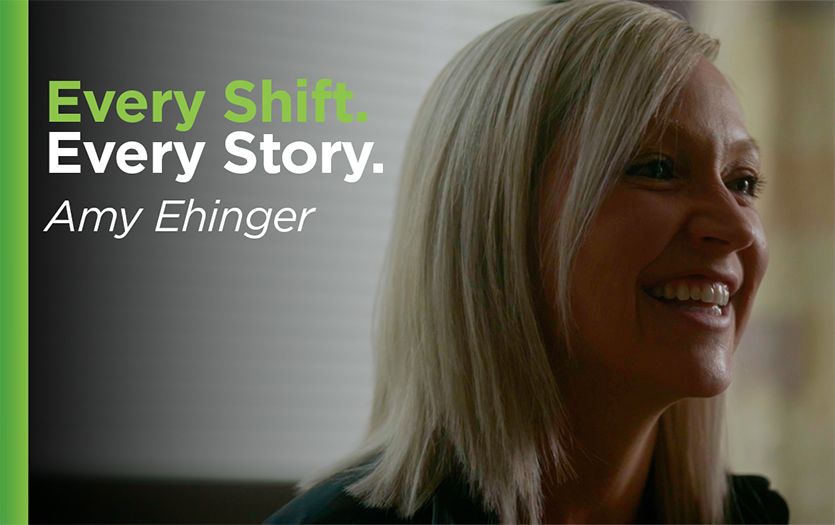
We invited Dawn Sturdivant, RN, Parkview Home Health & Hospice, to share a bit about her journey to being a hospice care provider.
The road to providing hospice care
I graduated from nursing school in 1997. Back then, in Labor and Delivery, moms would do a 24-hour stay in the hospital and then a postpartum nurse would come to them for a follow-up visit. And I just remember thinking, “I love this. I love going into the home.”
Labor and Delivery was my first love. I did it for 12 years. Then I worked in the Emergency Room for eight years, and I can tell you, the ER is a brutal place. Then my dad got diagnosed with lung cancer in 2011. He went into hospice care and died in 2013, and during his journey, I realized I wanted to pursue hospice. But I knew I was going to have to get some space from his death before I could transition.
On October 30, 2015, which was my grandmother’s birthday, I shadowed a hospice nurse. I remember going into the home with her and thinking, “This is where I belong.” I applied and got a position at Whitley, and started on December 28, 2015, the two-year anniversary of Dad’s death.
Nuances of the role
When people say, “It takes a really special person to be a hospice nurse,” and I used to get that in Labor and Delivery, too, I always share the same response. We come into people’s lives in very intimate moments – life and death – and so to me, it feels like an honor that the family would invite us into their home and trust us to be a part of that journey.
There are so many dynamics going on in people’s lives. And they are often exaggerated in times of death. Sometimes families are engaged, sometimes not. Sometimes they are feuding and I’m trying to help work out the psychological part of it.
At one point, I wanted to do midwifery, but my kids were busy and in sports and we didn’t have online schooling like we do today. But now I know that the Lord put me where I’m supposed to be. This is my home, and I can use my work as a ministry when people are accepting of that.
The patients
I just lost a patient on Sunday. His wife sent me a text that morning and let me know what was going on, and I went and sat with him for an hour and half. I asked him if he was afraid. And he said, “No, it’s really just them out there I’m worried about,” pointing to his wife and children. He asked if I would hold his hand, and of course, I did. He asked me what I was thinking, and I said, “I’m really just praying, and trying to figure out what I can do to make you comfortable. Can I pray with you?” He said I could.
I left before 5 o’clock, and it took me about 50 minutes to get home. Just after 7, his wife called and said his breathing had changed. He passed away a minute after I pulled out of my driveway. He had been so lucid when I was there, and two hours later, he was gone.
I asked if I could come back by sometime and see his daughter, who was flying in from out of town, and his wife said, “Yeah, you’re part of our family now.” That’s what nursing is about; building those relationships with people. I say the ER was brutal, not because I couldn’t deal with the pace, but because some people are meant to do that kind of nursing and others are meant to do the more intimate nursing.
Finding balance
I cry. We deal with hard things, and I can’t help it. But it shows that I’m human. I can handle the emotional aspect of it because I have faith, and, as hard as a death is, when people have that faith, they tell me they aren’t afraid. That’s the one thing I know for certain about death; that when you have faith, you know that this is not the end, it’s the beginning.
I had a patient whose husband had died ten years before. She was not doing well and we knew she was going to pass away. I saw her on New Year’s Eve, and I said, “Can you believe tomorrow it’s going to be 2019?” And she put her arms out, and said, “2019 is going to be a great year for me.”
A couple of days later, me, her daughter and her daughter-in-law were all sitting on her bed with her. And we had this great moment where, we all knew what was happening, but for that period of time it was just four women hanging out on a bed together talking. That’s the part I love.
The team approach
The biggest misconception about hospice is that we’re going to come in and give them medications that will shorten the time they have left. But once hospice is called in, we can get the patient things to make them much more comfortable in their own home. It’s about quality of life. People get tired. They don’t want to go back to the hospital and be poked.
Also, hospice is very holistic. It’s not just nurses coming in. It’s nursing assistants who help with baths and chaplains and social workers. It’s an amazing team of people.
To receive more information or refer a friend or family member for hospice care, call (260) 373-9800 or 800-363-9977, or visit parkview.com/hospice.



